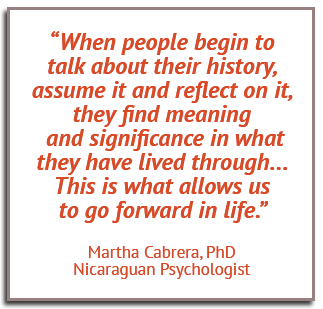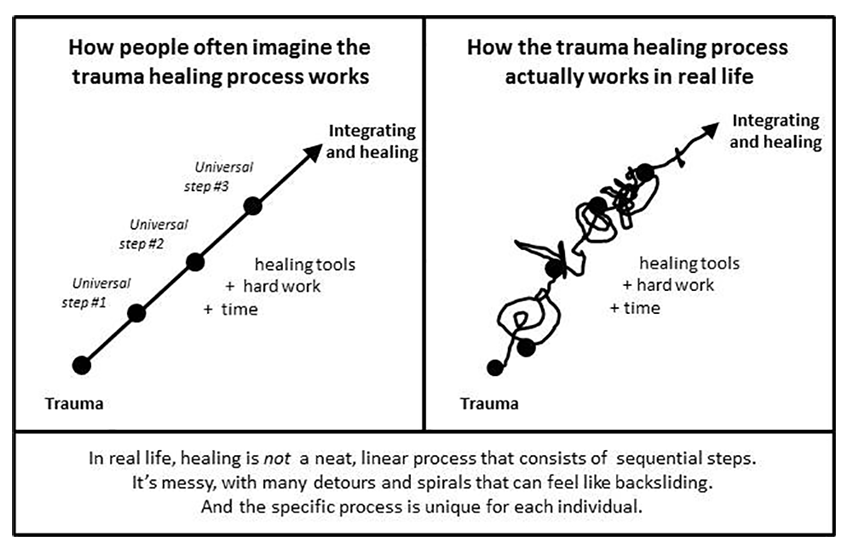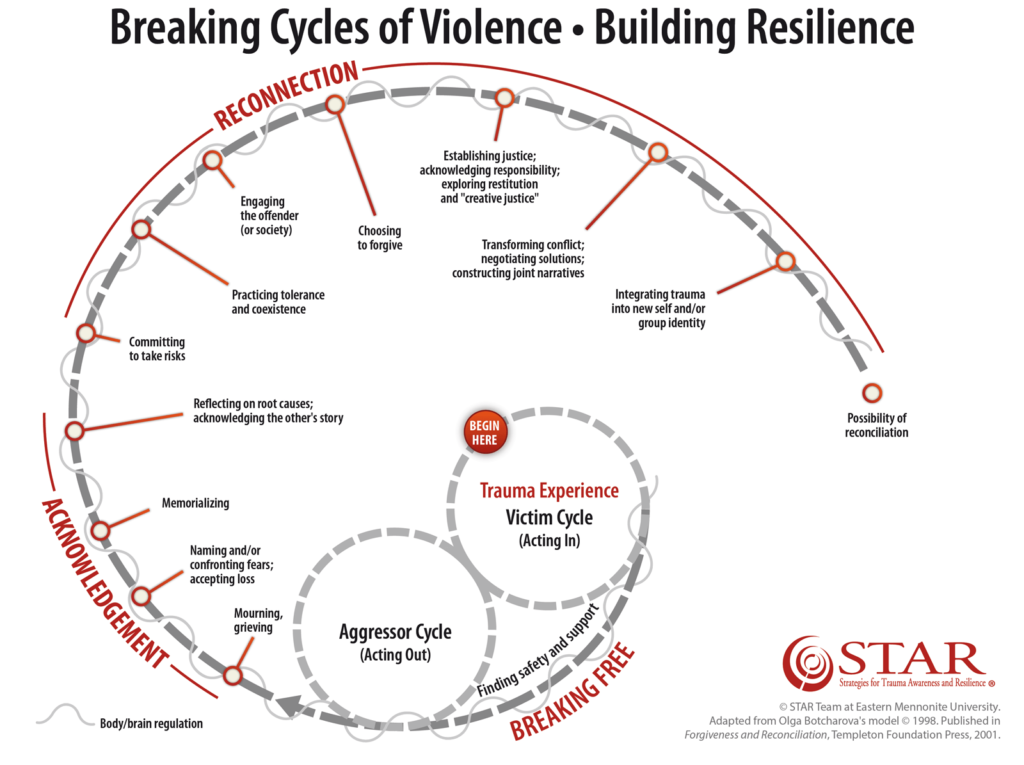Healing Tools
Healing tools and processes that build resilience
If you have read the Trauma Awareness pages, you know the normal responses to trauma. You understand the natural physiological reactions that human beings go through after a traumatic event, and how using simple can restore brain/body balance.
You also understand the Cycles of Violence that can result when trauma is unaddressed, when someone tries to ignore what they’ve been through and just “get on with life.”
You realize that there are people in your community or the population you work with who need help dealing with what happened. You may even feel as though you’re one of them. So what do you do?
In this page, you’ll find information about:
- Why people’s responses to trauma and the healing process is different (and how reality often differs from expectations)
- A model for breaking the cycles of violence from unhealed trauma and building resilience
- How to start putting the information in this model in practice
- The challenges and rewards of the healing process
- Where to find more trauma healing tools
People’s responses to trauma and the healing process differ
On a broad level, the overall healing process for individuals and communities involves three areas: safety to break free from cycles of violence, acknowledgment, and reconnection. (See next section below.)
On a more specific level, however, the steps that each individual person takes toward healing, and the order in which they take them, vary. One reason for this is that we don’t all respond in the same way to the same situation. What deeply traumatizes one person or community may not traumatize another, or traumatize to the same degree. Some of the factors that influence the extent to which an event is traumatizing include:
- Specific circumstances, i.e. whether what happened was an accident or deliberate harm
- Age of those involved
- Previous life experiences
- Resources available, especially the degree of social support
- The meaning individuals, communities, or societies give to what happened
However, despite our differences, we all experience the same initial physical response to trauma.
Another thing to keep in mind is that people sometimes imagine healing as a linear, step-by-step formula that they can “plug themselves into” and come out healed on the other side.
In reality, as the diagram below shows, the process is messy, filled with detours and spirals, and is unique for each individual or group.
The three general foundations of the “Breaking the Cycles of Violence” model
While there’s no one magic technique (or even step-by-step roadmap) for everyone, there are three broad areas which help healing to take place. These are:
- Safety to break free: Both individuals and communities need some degree of physical, emotional, or spiritual safety in order to think about addressing the impact of trauma. Releasing the physical effects helps people to think clearly, and reduces the chances of getting stuck in cycles of violence. If individuals or groups are already caught in Victim or Aggressor cycles, breaking free means recognizing this, and choosing a different way of responding. A way to begin is by identifying processes on the model that would be most helpful for them.
- Acknowledgement: Acknowledgement is about facing and mourning what happened, rather than suppressing grief. It’s about examining the meaning people have given to what happened. If the trauma involved someone harming them or their community, it’s about taking the time to understand the context of what happened. This means asking both “why me/us?” and “why did they do it” questions that get at the root causes. (Note: this does not mean in any way condoning what happened).
- Reconnection: Reconnection is about choosing to engage with the new reality and with “the other,” if the trauma was caused by another person or group. It involves learning different forms of justice to address what happened, considering forgiving, and using conflict transformation practices to move toward the future. It’s also about integrating what happened into a new individual or group identity—and it may or may not include reconciliation.
You can see each area of healing—and the specific tools and processes within it—in the diagram below. Obviously, these processes do not happen overnight. They can take months, or even years. The shape of the diagram itself is symbolic: a snail. But transformation and resilience result from the learning and growth.
How to start putting the information in this model into practice
To begin, look at the diagram above. Draw a circle to mark where your community or the individual you want to help sits right now.
If you’re not sure, these questions can help guide you:
- Has the trauma just happened? If so, the person (or people) you’re helping probably feels lost in the jumble of normal trauma reactions (or perhaps they simply feel numb). Start with the physical release exercises, and then look at the other tools on the diagram to identify those that would be most useful.
- Are you seeing signs of the Victim or Aggressor cycles? If so, look at which tools or processes in the Breaking Free, Acknowledgement, and Reconnection areas might help break the cycles of violence.
- Are people already actively working toward healing? If so, circle all the tools and processes they’re using right now. What else might complement these steps and help in moving forward? Are there additional steps or tools you could add to the diagram that you know have been helpful?
The healing process can be hard, and setbacks may happen
Healing is hard, often slow, work. At times, you and those you work with may feel discouraged and daunted. Along the way, you may well hit crisis points, such as another round of conflict or an event that puts nerves on edge. You may notice people slipping back into the cycles of violence. Everyone, including you, may be tempted to give up.
Leaders play a critical role at such times. You—and others—will have to choose again and again whether to keep going forward in ways that heal and bring life, or to react in ways that perpetuate cycles of violence.
Remember to take time to care for yourself so you don’t burn out. It’s far too large a task for any one person to manage alone or provide all the tools and resources a community might need in the wake of trauma. This is especially true if the traumatic events are ongoing.
You can help yourself and your community by categorizing the tools in the diagram above into those that:
- You can provide to your community yourself
- Are provided by other members or organizations in the community
- Are not currently available in your community, and will require you to bring in external help

But there also are rewards
In spite of obstacles, choosing to work toward healing does bring transformation, personally and to communities. The positive energy generated by consciously directing the energy of trauma into working toward change and healing propels people forward.
Things will never be “the way they were before” again. You and the people you work with will never forget what happened. Life will always bring challenges.
But learning new skills and healing approaches brings strength, growth, a sense of integration, and enhanced resilience. It brings hope. Cycles of life begin to replace fear and cycles of violence. This is PeaceAfterTrauma.
Where can you find more tools to help your community address trauma?
You can expand your own knowledge by:
- Signing up to be notified of PeaceAfterTrauma webinars through the form below
- Attending one of the STAR (Strategies for Trauma Awareness and Resilience) training


